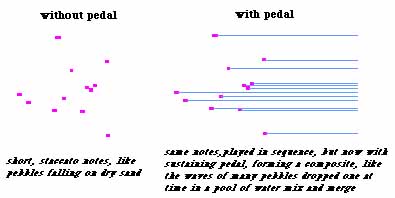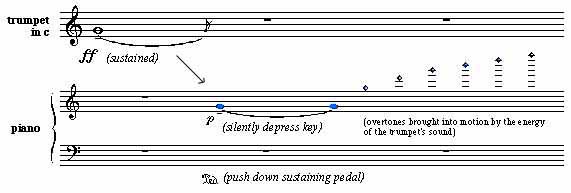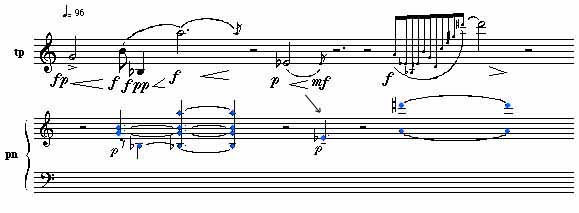 In this way, the sustaining pedal gives the
piano something like a built-in echo chamber; it is what allows an individual
performer to create a truly remarkable sense of space of almost orchestral
proportions. As is frequently the case with everyday miracles, however, I
feel that many classical musicians have in a way come to take this magnificent
pedal technology somewhat for granted. But for those of us, who, like myself,
In this way, the sustaining pedal gives the
piano something like a built-in echo chamber; it is what allows an individual
performer to create a truly remarkable sense of space of almost orchestral
proportions. As is frequently the case with everyday miracles, however, I
feel that many classical musicians have in a way come to take this magnificent
pedal technology somewhat for granted. But for those of us, who, like myself,
are more philosophically inclined and rather less gifted in playing our Bartók and Bach,
it is still possible to sit at the keyboard and ponder this uniquely mysterious movement.
We hear time -- or melody -- folding into pure space -- or harmony. In a way, this is
much like a colorful thread rolling itself up into a skein. One cannot help feeling
that something very profound is being revealed to us, but what exactly? We have this
relationship between:
time / space; melody / harmony.
Pondering this, like Rilke said, we are carried to a place "where all language ends,"
and where thought must naturally come to a stop.
The Affinity of Similarities
Yes, "push the pedals down." Even though the poem is short and rather playful in tone,
I do wish to suggest something of this quality of vast space. I also wish to go further and suggest
something still more subtle and perhaps a bit harder to visualize, but not to sense: the idea of
a motionless or neutral passivity which is at once quiet and yet full of energy, ready
to reflect or respond to the world which surrounds us.
Imagine this: The performer -- who is the both the poet (as well as you, the listener, perhaps)
-- takes his place center stage at the keyboard. But instead of touching the keys to
produce a sound, as in the above example, he simply depresses the pedals and
remains completely silent. Do you sense how the image moves very quickly
in several different directions at once? For me, these different possible vectors
of meaning all share the same idea, namely, that of sympathy.
A Play of Words and their Origins
In English, the word "sympathy"suggests a 'feeling with' or sharing something
of the emotion and experience of another. In other languages of Indo-European origin,
the adjective form, sympathetic, also implies 'one who is capable of this', as in
a friend who can not only be counted upon, but also who 'reads' our feelings without
having to say a single word. Like the Italians say, 'molto simpatico', or in Dutch,
'heel erg sympatiek,' both literally meaning, very sympathetic. Sympathetic in this
sense might be used to describe not only a person, but also, for example, something
less tangible, like a way of doing music or poetry. Perhaps we could say that this
is more than merely like or dislike, but rather a kind of deeply shared resonance or
mutual affinity. So instead of seeing the world as composed of static, isolated objects,
we are now entering a world of movements which merge and interpenetrate one another.
This naturally brings us back to musical instruments, both in actuality and as metaphor.
As they say very charmingly in German, 'mit schwingen', or literally, 'to swing
together with,' like two strings which move perfectly together. Rilke, the great
master of image-as-movement, awakens in us this very idea in the famous
Love Song which begins his New Poems:
"And yet everything which touches us, you and me,
takes us together like a single bow,
drawing out from two strings but one voice."
Sympathy. Mitschwingen. Moving together. Eight centuries before the Europe of Rilke,
the spiritual teacher and seer Mechtild of Magdeburg suggested something very
similar, only still more general:
"And all strings
Which are touched in Love
Must sound."
So, we see that a great deal is implied in the 'affinity' or 'moving together with'
which characterizes sympathy. Especially when sympathy moves on in depth and
subtlety to compassion which we might describe, following Jiddu Krishnamurti, as
'seeing the other in myself.' In this context, we might think of this as a kind of resonance
which is essentially selfless, or a 'swinging with' the whole of life. This is why,
in the poem, the performer is utterly without movement; he is there not so much
to play his own song but more as an instrument which manifests the voices he
hears around him.
The Poet as Beat-up Piano
Indeed, the mysterious world of sound and vibrating bodies demonstrates to us
in the most directly perceptible of ways that aspects of our consciousness as
complex as sympathy and compassion are incipiently already present in something
as simple as a single silent string. At the same time, it brings out an important limitation—
some might say, a tragic flaw, of the current electronic and computer technology.
I'll return to this last point briefly by way of conclusion.
In the spirit not of the Academy, but of true Phythagorians, pondering together
under starry night skies the significance of rhythm, mode and interval, I've sketched
out below in musical notation a simple experiment you might want to perform. What
I've done is to take, so to speak, the pebbles dropping in dry sand or quiet water above
and stepped them into a more abstract representation. But the idea is still that it is always
better to experience an acoustic principle first hand, instead of just thinking about
it intellectually. Then when we do think about it, our thought is perhaps rooted in
something deeper than mere numbers or what we see on the screen. To bring
out the difference, let me first introduce the sound experiment with
a little story:
Once, a number of years ago, a young boy visited a studio I was working
in at the time in the Netherlands. I had been out in the forest all day with his father,
a Dutch sod farmer, clearing a tangle of Douglas Fir windfall after a freak fall storm.
As we were coming inside, a bit cold and tired, the boy saw a shiny little brass
hunting trumpet I had laid out on top of an old grand piano that was standing in
the corner. (Personally, I don't play the piano much anymore, although I do
like to compose for it, and, if I can, have an instrument around simply for company.)
I handed the boy the trumpet, which wasn't much more than six feet of hammered
brass tubing with a mouth piece at one end, and told him to give it a loud blow.
Which he did. Then I said, "Listen to this!" while I pushed the pedals down
and he played another loud note. I didn't bother opening up the keyboard cover.
He was amazed. So was his father, who was watching somewhat anxiously
at a distance. How could it be, he thought, that the piano echoed, or reflected,
like a mirror made of sound, the different and yet similar sound of the trumpet.
But, of course, the trumpet was big or loud, while the piano's reflection was quite small
or soft. It was this difference of perspective that gave the sound such a great sense
of space, and which dumbstruck the boy. It was as if we were standing together,
all three of us, in an immense cathedral or concert hall.
A physicist calls this the principle of sympathetic resonance: two orders of similar
movement which merge to form a third which reflects in a unique way both. Notice
that the strings must be perfectly quiet for this to take place. And free. That is,
not impeded in any way.
Now, as for the music below. If you do not read musical notation, there's nothing
to fear. You can read the little score simply as a kind of graph, like, say, a market chart,
but with 'up' and 'down' representing not the vagaries of your portfolio, but rather
pure musical space or pitch. The movement from left to right is then time. In classical
music, time is notated or measured very precisely, always in relationship to
the movements of the body. The top 5 lines are for a transformation of the pebbles
into a modern symphonic trumpet, which in a clever way combines three of the hunting
horns mentioned above. The bottom two sets of 5 lines -- they're called staves --
are for our resonance clavier, -- the passive reflecting water. Indeed, at the poet's piano,
anyone can play, because all you have to do is push down a key or pedal without
making a sound! We only need listen carefully, and, perhaps, as Walt Whitman
once said, go "down to recognnoitre there a long time /
And bring back a report."

